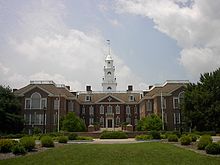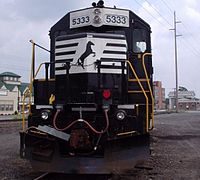Dover, Delaware
The city of Dover is the capital and second largest city[1] in the U.S. state of Delaware. It is also the county seat of Kent County, and the principal city of the Dover, Delaware Metropolitan Statistical Area which encompasses all of Kent County. It is located on the St. Jones River in the Delaware River coastal plain. It was named by William Penn for Dover in Kent, England. As of 2007, the city had an estimated population of 35,811.[2]
History
Dover was founded as the court town for newly established Kent County in 1683 by William Penn, the Proprietor of the territory generally known as the "Lower Counties on the Delaware." Later, in 1717, the city was officially laid out by a special commission of the Delaware General Assembly. The capital of the state of Delaware was moved here from New Castle in 1777 due to its central location and relative safety from British raiders on the Delaware River. The city's central square, known as The Green, was the location of many rallies, troop reviews, and other patriotic events. To this day, The Green remains the heart of Dover's historic district and is the location of the Delaware Supreme Court and the Kent County Courthouse.
Dover was most famously the home of Caesar Rodney, the popular wartime leader of Delaware during the American Revolution. He is known to have been buried outside Dover, but the precise location of his grave is unknown. A cenotaph in his honor is erected in the cemetery of the Christ Episcopal Church on The Green in Dover.
Dover and Kent County were deeply divided over the issue of slavery and was a "stop" on the Underground Railroad, due to its proximity to slave holding Maryland and free Pennsylvania and New Jersey. It was also home to a large Quaker community that encouraged a sustained emancipation effort in the early nineteenth century. There were very few slaves in the area, but the institution was supported, if not practiced, by a small majority, who saw to its continuation.
Geography
Dover is located at 39°9′43″N 75°31′36″W / 39.16194°N 75.52667°WInvalid arguments have been passed to the {{#coordinates:}} function (39.161921, -75.526755)Template:GR.
According to the United States Census Bureau, the city has a total area of 22.7 square miles (58.8 km²), of which, 22.4 square miles (58.0 km²) of it is land and 0.3 square miles (0.8 km²) of it is water. The total area is 1.32% water.
Demographics
In 1890, 3,061 people lived in Dover; in 1900, 3,329; in 1910, 3,720; and in 1940, 5,517. As of the censusTemplate:GR of 2000, there were 32,135 people, 12,340 households, and 7,502 families residing in the city. The population density was 1,435.0 people per square mile (554.1/km²). There were 13,195 housing units at an average density of 589.2/sq mi (227.5/km²). The racial makeup of the city was 54.94% White, 37.22% Black or African American, 0.45% Native American, 3.16% Asian, 0.04% Pacific Islander, 1.57% from other races, and 2.62% from two or more races. 4.13% of the population were Hispanic or Latino of any race.
There were 12,340 households out of which 30.0% had children under the age of 18 living with them, 40.4% were married couples living together, 16.7% had a female householder with no husband present, and 39.2% were non-families. 31.4% of all households were made up of individuals and 10.6% had someone living alone who was 65 years of age or older. The average household size was 2.35 and the average family size was 2.98.
In the city the population was spread out with 23.5% under the age of 18, 15.7% from 18 to 24, 27.9% from 25 to 44, 19.5% from 45 to 64, and 13.3% who were 65 years of age or older. The median age was 33 years. For every 100 females there were 88.9 males. For every 100 females age 18 and over, there were 85.1 males.
The median income for a household in the city was $38,669, and the median income for a family was $48,338. Males had a median income of $34,824 versus $26,061 for females. The per capita income for the city was $19,445. About 11.5% of families and 13.8% of the population were below the poverty line, including 19.6% of those under age 18 and 10.4% of those age 65 or over.
Economy

Delaware's largest employer is also Dover's – the state government. A large portion, but not all, of the state's bureaucracy is located in and around Dover. However, like some other American states, Delaware's capital is not its largest city. Consequently, Wilmington, in the northern part of the state and its largest city, has many state offices and employees one would normally expect to find in the state capital, including the headquarters of the Office of the Attorney General.
Dover is one of the fastest-growing areas in the State of Delaware, due in large part to the relatively low cost of living. As a consequence, the Kent County government is a major employer in the area as well. Apart from the state and county governments, Dover's significant employers include Dover Air Force Base, located within the southeast corporate limits of the city. The base houses two airlift wings as well as the U.S. military's only mortuary located in the continental United States, which accepts and processes the remains of soldiers killed in battle. In addition, the Playtex corporation, General Mills and Procter & Gamble have manufacturing facilities in Dover. ILC Dover, in nearby Frederica, is the producer of fabrics for military and aerospace uses, along with being the primary contractor for production of the Apollo and Skylab spacesuits, as well as the spacesuit assembly for the Space Shuttle's Extravehicular Mobility Unit (EMU).
Two weekends a year, NASCAR stock car races are held at Dover International Speedway, attracting over 100,000 spectators and visitors and temporarily making Dover the state's largest city. These races, and in recent years adjacent slot machine gambling, contribute millions of dollars to Dover's economy.
Dover is the only state capital in the United States with a volunteer fire department.
Transportation

The main north–south highway through Dover is U.S. Route 13, which runs through the main commercial strip of Dover on the multi-lane, divided Dupont Highway. An alternate route of U.S. Route 13, U.S. Route 13 Alternate, passes through downtown Dover on Governors Avenue. The Delaware Route 1 turnpike, which provides the main route to the Delaware beaches, passes to the east of Dover. It ends near the Dover Air Force Base and DE 1 continues south on Bay Road. U.S. Route 113 formerly ran along Bay Road from Milford to US 13 near the State Capitol Complex, however it was decommissioned in 2004 to avoid the concurrency with DE 1 between the Dover Air Force Base and Milford. Delaware Route 8 is the main east–west route through Dover, passing through downtown on Division Street and West Dover on Forrest Avenue. It continues west toward Maryland to provide access to the Chesapeake Bay Bridge. Dover is one of only five state capitals not served by an interstate highway. Pierre, South Dakota; Jefferson City, Missouri; Carson City, Nevada; and Juneau, Alaska are the other four state capitals with this distinction.
Dover Air Force Base is located within the southeast corporate limits of Dover, however the closest sizable civilian airport to Dover is the New Castle Airport in New Castle. The closest airports with commercial air service to Dover include the Wicomico Regional Airport in Salisbury, Maryland, the Baltimore-Washington International Thurgood Marshall Airport in Baltimore, Maryland, and the Philadelphia International Airport in Philadelphia, Pennsylvania.
Dover is located on a former Pennsylvania Railroad line which is now served by Norfolk Southern. At one time Dover had a daily Amtrak passenger service; however the line now is just used for local freight. The closest passenger rail station is the Amtrak station in Wilmington.
DART First State provides weekday local bus service throughout Dover, radiating from the Water Street Transfer Center in downtown. They also provide inter-county service to Wilmington and Georgetown and seasonal service to Rehoboth Beach.
Education
Dover is home to Delaware State University (a land-grant university and Delaware's only historically black university), and Wesley College. It is also home to the Terry Campus of the Delaware Technical & Community College and that college's administrative offices. Dover also has satellite locations of the University of Delaware and Wilmington University.
Three public high schools serve Dover residents. Caesar Rodney High School website, in the Caesar Rodney School District (located just outside the city in Camden-Wyoming); Dover High School, in the Capital School District; and Polytech High School, in the Polytech School District
The Dover Air Force Base Middle School is located on the premises of the Dover Air Force Base. This school is unusual in that it is run not by the Department of Defense, but by the Caesar Rodney School District.
Culture
The former Dover Opera House, built in 1904, was recently renovated and converted to the Schwartz Center for the Arts, which hosts performances by the Dover Symphony Orchestra, ballet, and classic films.
The Delaware State Library, Delaware State Museum, and the Delaware State Archives are located in downtown Dover and are open to the public for research and browsing.
In Dover's historical district is the Sewell C. Biggs Museum of American Art, featuring collections from the Colonial days to the present.
Media
Two newspapers are headquartered in Dover, they are the Dover post and the Delaware state news. WBOC-TV maintains a bureau in Dover and, WHYY-TV maintains a studio and broadcasting facility in Dover.
Sports
Dover International Speedway is home to two NASCAR race weekends in June and in September. Within Dover International Speedway is Dover Downs, a harness horse racing track.
The two colleges in town are both very active in sports, with Wesley being a perennial powerhouse in their conference in Division III football and Delaware State making the FCS playoffs for the first time in 2007.
For one week during the middle of July every year, Dover also hosts the Big League (Little League 16-18) Eastern Regionals, attracting teams from all of New England and the Mid-Atlantic.
There are several golf courses located near Dover. They include the Wild Quail Country Club near Camden, Jonathan's Landing Golf Course near Magnolia, Dover Center Par 3 and Driving Range in Dover, and the Dover Air Base Golf Course (Must have military I.D.) on the Dover Air Force Base.
Historically, Dover hosted a farm team of the Philadelphia Phillies in the Eastern Shore Baseball League. It also served as an affiliate of the minor league Baltimore Orioles. The teams were variously known as the Senators, Dobbins, Orioles, and Phillies.
In 2008 Sporting News ranked Dover 215th in its list of the 400 Best Sports Cities based on the year October 2007 - October 2008, a year which saw high attendance for the NASCAR races and Delaware State's football team make their first FCS tournament appearance.[3]
See also
- Teri Polo (actress born in Dover)
- Madison Brengle (rising tennis star playing for the Delaware Smash)
References
- ^ "Annual Estimates of the Population for All Incorporated Places in Delaware" (CSV). 2005 Population Estimates. U.S. Census Bureau, Population Division. June 21, 2006.
{{cite web}}: Unknown parameter|accessmonthday=ignored (help); Unknown parameter|accessyear=ignored (|access-date=suggested) (help) - ^ Population Estimates for All Places: 2000 to 2006
- ^ http://www.sportingnews.com/yourturn/viewtopic.php?t=468401

